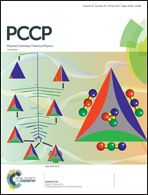Doped δ-bismuth oxides to investigate oxygen ion transport as a metric for condensed phase thermite ignition†
Abstract
Nanothermites offer high energy density and high burn rates, but are mechanistically only now being understood. One question of interest is how initiation occurs and how the ignition temperature is related to microscopic controlling parameters. In this study, we explored the potential role of oxygen ion transport in Bi2O3 as a controlling mechanism for condensed phase ignition reaction. Seven different doped δ-Bi2O3 were synthesized by aerosol spray pyrolysis. The ignition temperatures of Al/doped Bi2O3, C/doped Bi2O3 and Ta/doped Bi2O3 were measured by temperature-jump/time-of-flight mass spectrometer coupled with a high-speed camera respectively. These results were then correlated to the corresponding oxygen ion conductivity (directly proportional to ion diffusivity) for these doped Bi2O3 measured by impedance spectroscopy. We find that ignition of thermite with doped Bi2O3 as oxidizer occurs at a critical oxygen ion conductivity (∼0.06 S cm−1) of doped Bi2O3 in the condensed-phase so long as the aluminum is in a molten state. These results suggest that oxygen ion transport limits the condensed state Bi2O3 oxidized thermite ignition. We also find that the larger oxygen vacancy concentration and the smaller metal–oxide bond energy in doped Bi2O3, the lower the ignition temperature. The latter suggests that we can consider the possibility of manipulating microscopic properties within a crystal, to tune the resultant energetic properties.

- This article is part of the themed collection: 2017 PCCP HOT Articles


 Please wait while we load your content...
Please wait while we load your content...